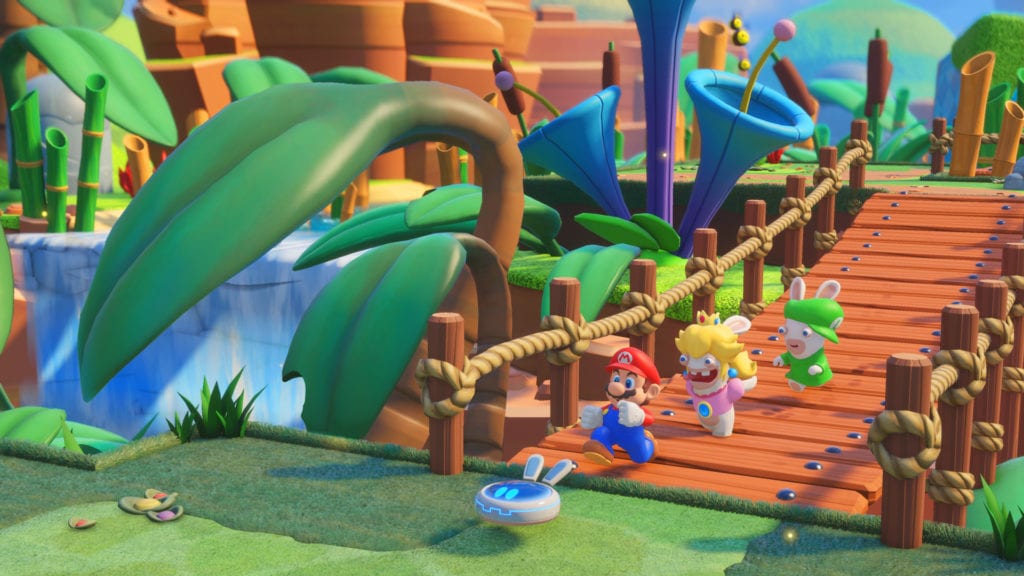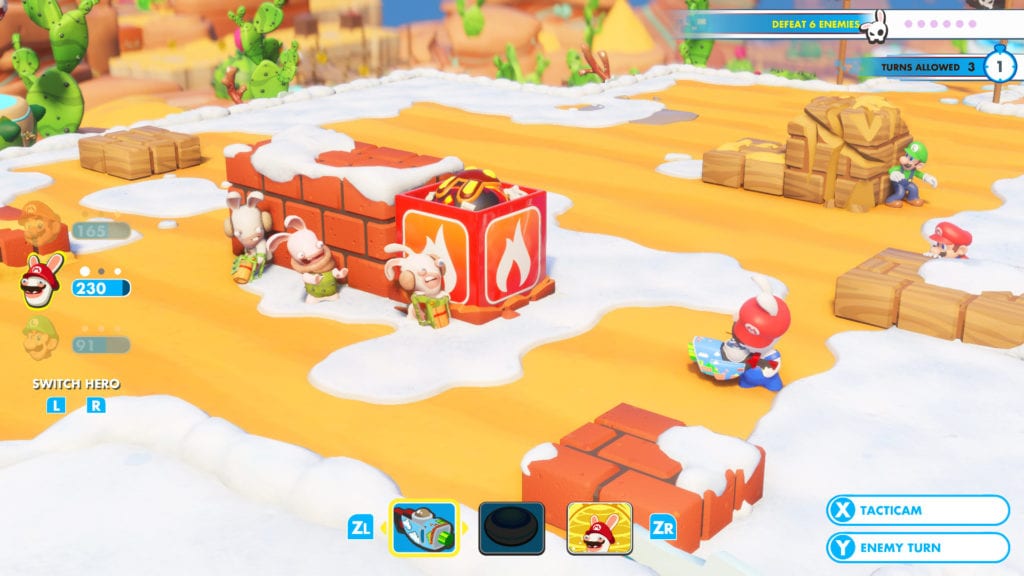Mario + Rabbids Kingdom Battle Review
Platform: Nintendo SwitchRelease Date: 8/29/2017
Publisher: Ubisoft
Developer: Ubisoft, Ubisoft Paris, Ubisoft Milan
ESRB: 10+
Two crazy worlds and two different IPs collided in late August for the release of Mario + Rabbids Kingdom Battle. When first announced the title seemed to have many gamers tilting their heads, wondering what to expect from this unlikely combination of characters. After having some time to play through the first few hours of the game, it clearly stands out as a must-have for Switch owners.
The game begins in a lab where an experiment goes wrong and combines the mischief loving Rabbids with the classic Mario characters gamers have known over the years, transporting them to the Mushroom Kingdom where the Rabbids (of course) bring chaos with them. Mario and his friends must team up with the Rabbids that bear their likenesses to bring an end to the chaos before Bowser and his minions gain control over the strange power that is causing the Rabbids to become enemies and terrorize the Mushroom Kingdom.

Gameplay
The gameplay mechanics are very similar to that of the XCOM franchise: turn-based team combat, maneuvering your heroes across the map, taking advantage of cover and altitude to find the best way to deal with the enemy at hand. While being a simplified version of the XCOM system, it still provides a good difficulty curve as the player progresses through the story.
Combat
Combat begins with the heroes together at the starting point of the map. Turns consist of the player rotating through their roster and choosing to move, buff or attack with each hero. Planning out which to do at what time is key to player strategy. Before moving them to another location on the map, players may want to apply a hero’s area-of-effect buff. Looking at where a hero can move before attacking can help the player get into cover, potentially blocking enemies from doing damage while allowing the player to counter-attack. Movement can also be used to get to higher ground, giving the hero an advantage and a damage bonus on attacks with the right upgrades to the hero’s skill tree. The player can also use the Team Jump skill to help move characters farther than their base movement. This can be helpful in flanking the enemy, gaining hard to reach higher ground or moving heroes toward an objective area more quickly. A character such as Mario can use this as a bonus attack, boosting to an enemy and landing on its head to cause damage. Once all heroes have moved, the enemy turn begins and follows the same format with all the same advantages of gaining cover and higher ground. Players must move their heroes across the map strategically to succeed in the current objective.
The combat in the game can begin to feel repetitive after a while, but the map layouts constantly change and provide new opportunities for strategy
Most of the time the objective is simple: defeat all enemies. Other objectives include getting one or more characters into a specific zone on the map (which will spawn more enemies every time you defeat one), or to defeat a specific number of enemies before the player is allowed to proceed. The combat in the game can begin to feel repetitive after a while, but the map layouts constantly change and provide new opportunities for strategy, depending on the enemies that have spawned and the current objective the game has laid out for the player. The map layouts are clearly catered to these various objectives, providing a refreshing break in the usual combat scenarios.
Arsenal Assembly
Hero loadouts are also a key mechanic of Mario + Rabbids Kingdom Battle. Each hero has a specific weapon and secondary weapon that only they can use, as well as a skill tree that builds on character combat, movement and technique. These can be upgraded by using power orbs that are found in chests throughout the world, or as rewards from combat.Each hero has special abilities including personal and team buffs and enemy debuffs. Learning to use these abilities at the optimal time is essential for survival against the various enemy types players will encounter throughout the campaign.
Exploration and Reward
A cornerstone of the Mario Universe, each world has its own theme, and exploration is rewarded. While traveling between combat areas on the map, players will encounter world puzzles that allow the player to obtain chests that can contain virtual 3D models and game art that can be viewed in the museum at Peach’s Castle, the hub world area of the game. They may also house various new weapons that can then be purchased for the heroes’ use, or power orbs that are used to unlock new abilities in heroes’ skill tree.
Challenges are a skill test for the player that can be replayed at any time once the challenge has been completed.
Once a world has been cleared, and the final boss for the area has been defeated, challenges are unlocked for that world. Challenges are a skill test for the player that can be replayed at any time once the challenge has been completed. The player can find these challenges by going back through the map and looking for a Rabbid dressed as Toad and talking to it. This provides great replayability value to the game as well as an extra goal for completionists.
Graphics and Engine
The visuals in the game look fantastic. The environments are colorful and cater to the design of each individual world that the player explores throughout their journey. While running at 900p when docked and 720p when undocked, the cartoonish nature of the art style does well to hide the lower resolution. While being capped at 30 FPS, frame rate issues do occur when too many particle effects are running at once, significantly dropping the FPS. The player may experience this during the critical hit cutscenes when the camera zooms in on the attacking hero or enemy, and noticeably slows the game.
The finely-tuned lighting and shadows throughout the environments show off a fantastic interpretation of time of day.
Running on the Snowdrop Engine, which was developed by Massive Entertainment, the game shines when it shows off the destructible cover throughout the environments. The finely-tuned lighting and shadows throughout the environments show off a fantastic interpretation of time of day.
The AI control implemented in the game is challenging, but fair. The enemies do not pull punches, demanding that the player uses all of the strategic tools at their disposal in every encounter.
Conclusion
So far, the game has surpassed expectations. The combat system is smooth and has depth, the characters of both the Mushroom Kingdom and Rabbids all have great personality to them. Most of all, it feels like a game in the Mario world. This is a brand new developer and a brand new genera for Mario, taking the classic characters that gamers have grown to know and love throughout generations of gaming and putting them in an unfamiliar setting. Risky as it was to try something new with these classic characters, crossing the IP with Rabbids somehow makes it work that much better. The Rabbids fit well into the Mario universe. Cartoonish and silly, it is easy to believe that they can coexist, even through their chaotic nature, in the Mushroom Kingdom. Time investments are entirely up to the player. It holds its appeal over the course of a longer session, or pick up for a couple of quick battles. The difficulty curve of the game consistently increases from world to world and map to map, introducing new enemies and map mechanics. The graphics look fantastic on the Nintendo Switch, both in portable mode and while docked. Most importantly it is a ton of fun. If you have a Switch or are just a Nintendo fan, this is a title worth picking up.
No related posts.







